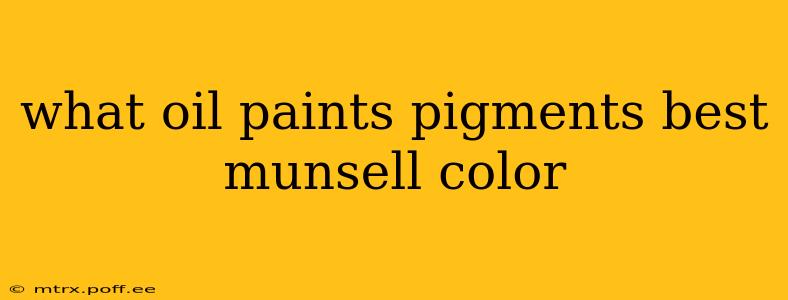What Oil Paint Pigments Best Match Munsell Colors?
The Munsell color system is a widely recognized color space that organizes colors based on hue, value (lightness), and chroma (saturation). Matching Munsell colors precisely with oil paint pigments can be challenging due to the inherent variations in pigment manufacturing, the complexities of mixing, and the subjective nature of color perception. However, we can explore the best approximations for achieving specific Munsell hues using readily available oil paint pigments. This guide won't provide exact matches – those require specialized color matching tools and a deep understanding of color theory – but will offer strong starting points for artists seeking to translate Munsell notations into oil paint mixtures.
It's crucial to remember that:
- Pigment brands vary: The exact color of a pigment named "Cadmium Yellow" will vary slightly depending on the manufacturer (e.g., Winsor & Newton, Gamblin, Old Holland).
- Mixing is key: Achieving precise Munsell colors often requires skillfully mixing several pigments.
- Substrate and lighting: The color you see will also be impacted by the surface you're painting on and the lighting conditions.
Understanding Munsell Notation:
Before diving in, let's quickly review the Munsell notation. A typical notation looks like this: 5YR 6/10.
- 5YR: This represents the hue (5YR is a reddish-yellow). The number indicates the position on the hue circle.
- 6: This is the value (lightness), ranging from 0 (black) to 10 (white). 6 is a mid-tone.
- 10: This is the chroma (saturation), ranging from 0 (neutral gray) upwards. 10 indicates high saturation.
Matching Specific Munsell Colors with Oil Paints: Approximations
To illustrate, let's look at a few examples. Remember that these are approximations and may need adjustment depending on your specific pigments and desired effects.
1. 5YR 6/10 (Reddish-Yellow, Mid-Tone, High Chroma):
A good starting point would be to mix Cadmium Yellow Light and Cadmium Red Light. The ratio will need careful adjustment to achieve the precise 6/10 value and chroma. You might need to add a touch of white (Titanium White) to lighten or a touch of a darker pigment (like Alizarin Crimson) to deepen the value as needed.
2. 10PB 5/4 (Bluish-Purple, Mid-Tone, Low Chroma):
This color is a muted purple. Ultramarine Blue and a touch of Permanent Rose or Dioxazine Purple could form a base. The low chroma suggests you'll need to add a neutralizer such as a small amount of black (Ivory Black or Mars Black) or a gray mix to dull the vibrancy and attain the desired muted tone. Careful manipulation of the ratios is crucial here.
3. 7.5GY 8/2 (Greenish-Gray, Light, Low Chroma):
This is a very light, muted grayish-green. Start with Titanium White as your base. Then introduce a small amount of Phthalo Green (Yellow Shade) and a touch of a cool gray (e.g., a mixture of Ultramarine Blue and Titanium White). The challenge here lies in achieving the balance between gray and green while maintaining the lightness.
How to Improve Your Munsell Color Matching Skills?
- Color charts: Obtain Munsell color charts for reference.
- Color mixing experiments: Practice mixing colors systematically, recording your ratios and observations.
- Color matching software: Several software programs can help simulate color mixtures.
- Understand undertones: Be aware that pigments often have subtle undertones that can significantly impact the final color.
- Patience and practice: Mastering color mixing takes time and dedication.
Frequently Asked Questions (PAA):
Q: Can I accurately match any Munsell color with oil paints?
A: While you can get very close, achieving a perfect match for every Munsell color with readily available oil paints is often difficult. The inherent variations in pigments and the complexities of mixing make exact replication a challenge.
Q: Are there specific oil paint brands better for Munsell color matching?
A: Many professional-grade oil paint brands (Gamblin, Winsor & Newton, Old Holland, etc.) offer a wide range of pigments with good color consistency. However, the brand itself doesn't guarantee a perfect match; the skill of the painter in mixing remains crucial.
Q: What tools can help in Munsell color matching?
A: Color charts, color mixing software, and colorimeters (instruments that measure color) can assist in the process.
This article aims to provide a general guide. The successful replication of Munsell colors using oil paints requires a deep understanding of color theory, extensive experimentation, and a keen eye for color.
